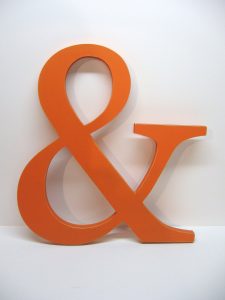
The ampersand. We all see it more than we actually write it and yet it is one of the handiest characters around. In fact one of its primary uses is in business names, presumably so that they will fit on business cards.
Unlike the Oxford comma, there is no raging battle among grammarians about the use of this character.
Where Did the Ampersand Come From?
The physical shape of the character predates the name (ampersand) by at least 1,500 years. Back in the first century, Roman scribes plied their trade in cursive. Because of this they penned the Latin word et which means “and” they linked up the e and t. As time went on the combination of letters came to signify the word “and” in English too. Some versions of the character, like that clearly reveal the origin of the shape.
“Ampersand” as a name came years later when “&” was a full-fledged member of the English alphabet. During the early 1800s school children reciting their ABCs finished their recitation with the &. It was too confusing to say “X, Y, Z, and.” So instead the students said, “and per se and.” “Per se” is Latin for “by itself,” so the students were basically saying, “X, Y, Z, and by itself and.” As time unfolded, “and per se and” was slurred together into the very word we use today — ampersand. When a word comes about from a mistaken pronunciation, it’s called a mondegreen.
Looking for more great content? Visit our partner sites:
I offer article and blog-writing services. Interested? Hire Me!
Did you find this article helpful? Thanks for supporting this free site with a small donation!
Visit Kelly’s profile on Pinterest.



